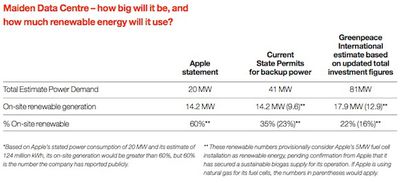Earlier this year, environmental activist group Greenpeace made waves with a report taking Apple and other companies to task for not doing enough to eliminate the use of dirty coal-sourced power at their data centers. Apple quickly responded at the time to note that Greenpeace had greatly overestimated the power needs of the company's flagship data center in Maiden, North Carolina, thereby understating the impact of Apple's solar and fuel cell power generation occurring at the site.
In that statement, Apple refuted Greenpeace's estimate of peak power demand of 100 megawatts for the data center, revealing that power demand would actually peak at 20 megawatts. And a month later, Apple published additional details on its efforts to run all of its data centers on 100% green energy.
Greenpeace announced yesterday that it has prepared an updated report on Apple's energy usage based on the new information, but as noted by Data Center Knowledge's Rich Miller, the group still seems to be being overly critical in its grading of Apple, even continuing to make up its own estimates of the North Carolina data center's energy usage rather than believing Apple's public statements.
In its initial report in April, Greenpeace estimated Apple’s power use in North Carolina at a whopping 100 megawatts. The group has reduced that slightly to 81 megawatts, dismissing the company’s disclosure that it expects draw about 20 megawatts at full capacity.
Miller goes on to note that Apple has clearly disclosed in regulatory documents that it intends to install backup generators capable of producing 41 megawatts of electricity in an "N+2" configuration that keeps at least two generators as spares, meaning that Apple is only planning for peak demand of 35-36 megawatts at an absolute maximum.

Miller points to two possible reasons for Greenpeace's continued refusal to acknowledge Apple's statements and other official documents addressing the data center's power needs:
Greenpeace’s continuing use of this methodology, in light of Apple’s disclosure and permit data, raises several possibilities:
- Greenpeace is having difficulty developing estimates that accurately incorporate data center operations and power usage.
- Greenpeace is predisposed to cling to estimates that make Apple look less “green” because it generates more headlines for its awareness campaigns.
For its part, Apple has continued to stand by its earlier comments, issuing a statement to Forbes:
We’re committed to building the world’s most environmentally responsible data centers and are leading the industry in the use of renewable energy, including the nation’s largest private solar arrays and non-utility fuel cell installation,” Kristin Huguet, an Apple spokewoman, said today. “As we’ve said before, our North Carolina and California data centers will be coal-free as of February 2013 and our newest data centers in Oregon and Nevada will be designed to meet that standard from Day One.”
Greenpeace's revised report gives Apple no additional credit for transparency, despite the company having explicitly revealed the power requirements of the data center, and the group's insistence on sticking with an 81-megawatt estimate of peak power capacity brings Apple's usage of renewable energy at the site down to just 22% as opposed to the 60% figure explicitly stated by Apple.
Greenpeace is also reluctant to give Apple credit for its fuel cell installation, waiting to hear whether Apple will actually be using biogas to directly power the cells or if it will be using natural gas and instead purchasing biogas to be inserted elsewhere in the distribution system to offset the company's natural gas usage. But given that Apple's biogas commitment would have the same net effect on overall natural gas consumption regardless of where exactly in the distribution system it is used, it seems that Apple should be pursuing the most cost-effective strategy for deploying that biogas.






















